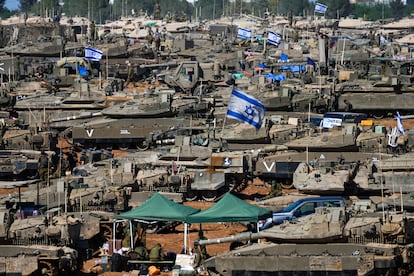Netanyahu pressures Hamas with Rafah invasion to unblock ceasefire talks
The Israeli army is holding the positions it gained Tuesday in southeastern Gaza but without launching a large-scale operation. In parallel, a delegation is negotiating in Cairo to secure the release of hostages

Israel, led by Prime Minister Benjamin Netanyahu, continues to focus on attacking while negotiating a possible ceasefire. The army is holding the positions it gained in the early hours of Tuesday in Rafah, in the southeast of the Palestinian enclave. It has not advanced on the ground, nor has it occupied the urban area or carried out large-scale incursions into densely populated parts of the city. But the Israel Defense Forces (IDF) reported on Wednesday that troops were carrying out a “precise counterterrorism operation within specific areas of eastern Rafah” to weaken Hamas. At the same time, airstrikes are continuing over densely populated areas, as the southern tip of the Gaza Strip, where Rafah is located, is now housing around 1.5 million people who are not receiving humanitarian aid, the United Nations has denounced.
More than 24 hours have elapsed since the Israeli assault and takeover of the strategic border crossing between Gaza and Egypt. The decision to invade the Rafah area without entering the population center confirms the strategy outlined by Netanyahu, who insists that Hamas fundamentalists have four battalions there. The idea is to use this operation as a weapon of pressure against the fundamentalist militia in the ceasefire negotiations that will allow for the release of hostages.
At the same time, the Israeli leader is caught in the middle of a complicated political and social balancing act where he must take into account the internal counterweights that keep his government under threat, and the international pressure to not destroy Rafah, where it is assumed that the majority of the some 130 hostages still in the Strip are being held. It is estimated that several dozen of them may have died. Their relatives also pressure Netanyahu every day with demonstrations.
Ceasefire talks in Cairo
In parallel, an Israeli delegation remains in Cairo, which the local media has described as low-profile, enough to suggest the indirect contacts with the Hamas leadership to reach a ceasefire agreement have not ended. There has been no progress in the Egyptian capital but the negotiators will continue there, an official source told Reuters Wednesday.
Meanwhile, CIA director William Burns traveled to Israel Wednesday after holding meetings in Qatar and Egypt, the two leading mediating countries alongside Washington. The head of U.S. intelligence will meet with Netanyahu, in addition to holding other talks with the intention of ironing out differences with Hamas.
The White House has defended the presence of the Israeli military inside Rafah, despite criticizing the intention to invade the area in recent weeks. Washington expressed reservations, especially since Israel had no plan to safeguard the hundreds of thousands of civilians packed into the south of the Strip. The vast majority have already been displaced from other parts of Gaza and headed south after Israel promised it was a safe zone.
“People are wondering where to go,” says Mohamed Al Najjar, a 23-year-old law student, via voicemail messages from the Tel Al Sultan neighborhood in western Rafah, as he watches cars loaded with families drive by. That is the farthest area — about five kilometers (3.1 miles) — from the border crossing taken by the occupying troops, so Al Najjar’s family has no plans at the moment to leave the building in which some 50 people of all ages are sheltering. “We live in a permanent state of confusion, not knowing what to do, because there is no safe place in Rafah.”
“The streets of the city echo with the cries of innocent lives lost, families torn apart and homes reduced to rubble. We stand on the brink of a humanitarian catastrophe of unprecedented proportions,” warned Rafah Mayor Ahmed Al-Sofi in an appeal to the international community to intervene, reports Reuters. “There has been continuous shelling in this area throughout the day. No fuel or aid has been coming in,” he added.
A major concern for the United Nations and humanitarian organizations is how the arrival of Israeli troops in Rafah will complicate providing aid to displaced Gazans. Israel announced Wednesday that it was reopening the Kerem Shalom border crossing, which has been closed since Hamas launched an attack last Sunday that killed four Israeli servicemen. Late on Wednesday, an Israeli military spokesman told Efe news agency that Israel had closed the crossing again, following an alleged new attack by Hamas. The Rafah crossing, the other route through which humanitarian aid enters the Strip, remains closed.
Humanitarian aid
The United Nations agency for Palestinian refugees (UNRWA) warns that no aid in the form of food or fuel is reaching Gaza, which is “disastrous for the humanitarian response,” said UNRWA spokeswoman Louise Wateridge. In the area around Kerem Shalom, which Israel claims to have reopened, “there are ongoing military operations and it is an active war zone. We are hearing continuous shelling in this area throughout the day,” she added. Israel has released a video taken with a drone showing the movement of trucks in Kerem Shalom.
“Without fuel all humanitarian operations will stop. Hospitals in the south of Gaza only have three days of fuel left, which means services may soon come to a halt,” Tedros Adhanom Ghebreyesus, director general of the World Health Organization, stated on X. “One of the three hospitals in Rafah, Al-Najjar, is no longer functioning due to the ongoing hostilities in its vicinity and the military operation in Rafah.”
Faced with the uncertainty of a potential more destructive military advance, around 10,000 people have left their homes or tents since Monday for a place they consider safer, according to UNRWA data, after Israel issued evacuation orders to the inhabitants of several neighborhoods in eastern Rafah. However, there is no safe zone in Gaza, according to citizens and humanitarian organizations, contradicting the maps with which Israel tries to guide the evacuations — particularly to the Al Mawasi encampment area north of Rafah — which in reality are forced population displacements considered illegal by the United Nations.
“In Rafah I saw amputee children living in tents because the hospitals were full. Those children are now being told, along with many others, to go to areas like Al Mawasi, which are considered safe. There, UNICEF reported a couple of weeks ago the case of a boy, Mustapha, who left home to get parsley for dinner and was shot in the head. Mustapha was killed in the so-called safe zone of Al Mawasi,” James Elder, spokesman for the UN agency, said from Geneva on Monday.
Mohamed Al Najjar sends EL PAÍS a video of a deserted street in Rafah, with shuttered stores, full of garbage, and with the wind blowing plastic bags among the squawking of birds. “This street was crowded until two days ago!”
Sign up for our weekly newsletter to get more English-language news coverage from EL PAÍS USA Edition
Tu suscripción se está usando en otro dispositivo
¿Quieres añadir otro usuario a tu suscripción?
Si continúas leyendo en este dispositivo, no se podrá leer en el otro.
FlechaTu suscripción se está usando en otro dispositivo y solo puedes acceder a EL PAÍS desde un dispositivo a la vez.
Si quieres compartir tu cuenta, cambia tu suscripción a la modalidad Premium, así podrás añadir otro usuario. Cada uno accederá con su propia cuenta de email, lo que os permitirá personalizar vuestra experiencia en EL PAÍS.
¿Tienes una suscripción de empresa? Accede aquí para contratar más cuentas.
En el caso de no saber quién está usando tu cuenta, te recomendamos cambiar tu contraseña aquí.
Si decides continuar compartiendo tu cuenta, este mensaje se mostrará en tu dispositivo y en el de la otra persona que está usando tu cuenta de forma indefinida, afectando a tu experiencia de lectura. Puedes consultar aquí los términos y condiciones de la suscripción digital.
More information
Archived In
Últimas noticias
Most viewed
- Reinhard Genzel, Nobel laureate in physics: ‘One-minute videos will never give you the truth’
- Oona Chaplin: ‘I told James Cameron that I was living in a treehouse and starting a permaculture project with a friend’
- Pablo Escobar’s hippos: A serious environmental problem, 40 years on
- Why we lost the habit of sleeping in two segments and how that changed our sense of time
- The fall of a prolific science journal exposes the billion-dollar profits of scientific publishing











































